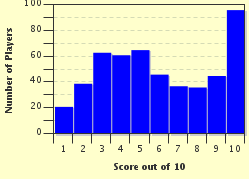Quiz Answer Key and Fun Facts
1. At the next coronation, I am entitled to wear a crimson velvet robe trimmed with four bands of ermine on either side, and a gold coronet decorated with eight strawberry leaves. Which of these four am I?
2. The green beret is the headgear worn by a very tough soldier. Who wore the first green berets?
3. You're walking down a street in New York and you meet a man wearing a fur-trimmed hat and a long black coat. What does his clothing tell you about him?
4. You're in London for the Trooping of the Colour on the Queen's official birthday when you see a cavalry troop wearing helmets with white plumes. To which regiment do they belong?
5. Who wears a fustanella?
6. He can't find his corbatin, and he can't go to work without it. What's his profession?
7. Where would you wear your skean dhu?
8. What does the Phrygian cap signify?
9. What is a cwcwll tal?
10. Who wears or wore the Kakars?
Source: Author
Cymruambyth
This quiz was reviewed by FunTrivia editor
looney_tunes before going online.
Any errors found in FunTrivia content are routinely corrected through our feedback system.

